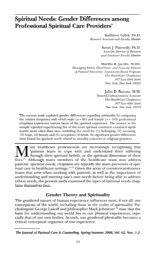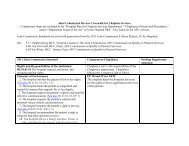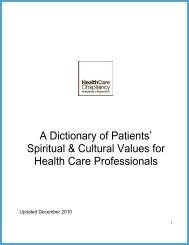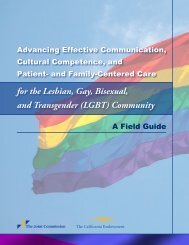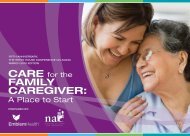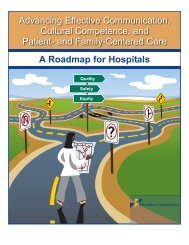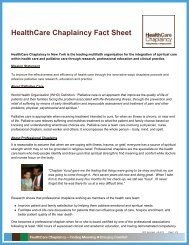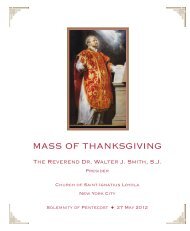The Beacon Summer 2007 - HealthCare Chaplaincy
The Beacon Summer 2007 - HealthCare Chaplaincy
The Beacon Summer 2007 - HealthCare Chaplaincy
Create successful ePaper yourself
Turn your PDF publications into a flip-book with our unique Google optimized e-Paper software.
<strong>Beacon</strong><br />
<strong>The</strong><br />
Vol. 32 No. 2/<strong>Summer</strong> <strong>2007</strong><br />
News from <strong>The</strong> <strong>HealthCare</strong> <strong>Chaplaincy</strong> – A Multifaith Center for Pastoral Care, Education & Research<br />
2<br />
INSIDE<br />
Rabbi Daniel Coleman on<br />
journeying with a patient<br />
5<br />
Introducing our new trustees<br />
8<br />
9<br />
10<br />
New Director of CSJPC,<br />
Rabbi Charles Sheer<br />
Fr. Jozef Krajnak on the universal<br />
language of pastoral care<br />
New Assistant VP for Advancement,<br />
Nicholas L. Grimaldi<br />
John Templeton Foundation Awards<br />
<strong>The</strong> <strong>HealthCare</strong> <strong>Chaplaincy</strong> $1.1 Million<br />
June<br />
J<br />
20 was a “red-letter day” for <strong>The</strong><br />
<strong>HealthCare</strong> <strong>Chaplaincy</strong>. That’s when the John<br />
Templeton Foundation notified president and<br />
CEO, the Rev. Dr. Walter J. Smith, S.J., that it had<br />
approved—in full—<strong>The</strong> <strong>Chaplaincy</strong>’s request for<br />
$1.1 million to help transform the curriculum and<br />
educational paradigm by which clinical pastoral<br />
educators are taught. It is the largest single grant<br />
<strong>The</strong> <strong>Chaplaincy</strong> has received in its forty-six year<br />
history and will be distributed over three years.<br />
“For decades, the <strong>Chaplaincy</strong> has been growing in<br />
its reputation as a leader and innovator in the pastoral<br />
care, education, and research fields,” said Fr.<br />
Smith. “Now, with the support of the John Templeton<br />
Foundation, we have set some ambitious goals to<br />
move the profession farther ahead.”<br />
“By revamping the way CPE faculty are mentored,<br />
taught, evaluated, and credentialed, not only will<br />
we develop new curricular and assessment tools,<br />
but we will also help the profession-at-large establish<br />
new benchmarks for the educational formation<br />
of a diverse<br />
group of new<br />
leaders for the<br />
twenty-first century.<br />
In short,<br />
thanks to the<br />
John Templeton<br />
Foundation, we’re now in a unique tactical position<br />
to be an effective channel for change within<br />
the global, multifaith spiritual care community,”<br />
said Fr. Smith.<br />
Dr. Paul Wason, director of life sciences at the John<br />
Templeton Foundation, said, “I was immediately<br />
impressed with <strong>The</strong> <strong>HealthCare</strong> <strong>Chaplaincy</strong>’s<br />
vision for developing this very important profession.<br />
But equally important, from my perspective, is<br />
that they have developed an excellent strategy to<br />
reach it.”<br />
In taking on this academic challenge, <strong>The</strong><br />
<strong>Chaplaincy</strong> is shifting its educational priority and<br />
becoming a dedicated doctoral-level clinical education<br />
C O N T I N U E D O N P A G E 4<br />
Chaplain Peggy Muncie Featured in<br />
Photograph by Ruby Washington/<strong>The</strong> New York Times<br />
Offering Comfort to the Sick and<br />
Blessings to <strong>The</strong>ir Healers<br />
In the Trenches, <strong>The</strong> Hospital Chaplain<br />
By Jan Hoffman<br />
READ THE FULL STORY ON PAGES 6-7
Lifting the<br />
Spirit<br />
A Message from the Rev. Dr. Walter J. Smith, S.J., President & CEO<br />
“Don’t we need baking powder, Guido?”<br />
During the first week of July, I was invited by friends to join them for<br />
five days at an Italian cooking school in an 11th century Benedictine<br />
abbey, Badia a Coltibuono, in Tuscany. Famed cookbook author<br />
Lorenza de’ Medici started the school some years ago in her family’s<br />
estate. Now, her youngest son, Guido Stucchi Prinetti, has taken up his<br />
mother’s whisk and mezzaluna, directing the program for eager students<br />
from around the world.<br />
One morning we were working our way through an ambitious program<br />
of five preparations, including biscotti. Deftly, Guido blended<br />
together butter, shortening, and sugar, vigorously beating in farm-fresh<br />
eggs. While talking about the origin of biscotti, he quickly added lemon<br />
extract, a pinch of salt, and liberal cups of flour before adding to the<br />
mixture a handful of toasted almonds. Guido was now ready to<br />
demonstrate how to form the dough into logs when someone said,<br />
“Don’t we need baking powder, Guido?” Distracted by his own storytelling,<br />
he had omitted the single teaspoon of leavening that would<br />
make a world of difference to the success of these classic Italian cookies.<br />
Without losing a beat, Guido reached for the powder, sprinkled it over<br />
the mixture, and kneaded it quickly into the dough with a broad smile<br />
and exuberant expression of gratitude to the attentive student.<br />
Can a single teaspoon of a leavening agent make such a difference?<br />
Indeed it does. Thanks to the release of carbon dioxide bubbles in the<br />
dough, our biscotti that morning rose beautifully as they baked. Later,<br />
we dipped them into glasses of Vin Santo del Chianti Classico. Deliziosi!<br />
With its history-making grant, the John Templeton Foundation has<br />
become an important leavening agent for <strong>The</strong> <strong>HealthCare</strong><br />
<strong>Chaplaincy</strong>. Over the past decade, <strong>The</strong> <strong>Chaplaincy</strong> has been strategically<br />
transforming its clinical pastoral education program into one of<br />
the most culturally and religiously diverse initiatives of its kind in the<br />
world. It has also been attracting attention for the caliber of new<br />
leaders it is preparing—the clinical educators of the future.<br />
All of the essential ingredients are in <strong>The</strong> <strong>Chaplaincy</strong>’s mixing bowl.<br />
By its $1.1M commitment, the John Templeton Foundation has supplied<br />
“baking powder” to the recipe, helping to ensure the success of<br />
<strong>The</strong> <strong>Chaplaincy</strong>’s pioneering initiative to create a doctoral-level curriculum<br />
for the education of CPE supervisors. Additionally, the<br />
Foundation is providing us with renewed funds to develop further<br />
our successful postdoctoral fellows program, which its seminal grant<br />
in 2003 helped us to establish. Over the next few years, in these pages<br />
you will see many new things “rising.” With the help and encouragement<br />
of our academic and philanthropic partners—like the John<br />
Templeton Foundation—<strong>The</strong> <strong>HealthCare</strong> <strong>Chaplaincy</strong> has a fail-safe<br />
recipe by which to pursue its commitment “to excellence and leadership<br />
in pastoral care, education, and research.” ■<br />
<strong>The</strong> Rev. Dr. Walter J. Smith, S.J.<br />
President & CEO<br />
Healing Moments<br />
“For Thou Wilt Light My Candle...”<br />
Rabbi Coleman with his wife,<br />
Anat, and son Akiva at the <strong>2007</strong><br />
commissioning ceremony.<br />
Recently I visited a<br />
patient at North Shore<br />
University Hospital<br />
who had been admitted with<br />
severe emphysema. Though she<br />
had trouble breathing, she got<br />
right to the point: A former<br />
alcoholic and still a heavy<br />
smoker, she said she felt guilty<br />
about killing herself. “I’m dying<br />
for a cigarette,” she admitted.<br />
But she had more than medical<br />
problems on her mind. She said<br />
she had been estranged from her family for a long time and had<br />
only one friend. That’s when I began a life review with her.<br />
Only in her fifties, this patient told me she had been an elementary<br />
school teacher for decades, so we reflected on the many<br />
lives she touched over the years. That was the opening she<br />
needed. She talked about her family, regretting that she couldn’t<br />
be there for them when she was drinking. She felt it was too<br />
late for reconciliation, but wished they could know that she had<br />
tried her best to straighten out her life and was sorry she had let<br />
them down.<br />
Before I left that Wednesday, she asked me to bring her a set of<br />
electric Sabbath candles to my next visit. Though our conversation<br />
hadn’t touched on religion, I happily agreed.<br />
2 <strong>The</strong> <strong>Beacon</strong>
Italian Biscotti<br />
Ingredients<br />
4 tablespoons unsalted butter<br />
1<br />
/4 cup shortening<br />
3<br />
/4 cup sugar<br />
3 large eggs<br />
1 teaspoon pure vanilla extract<br />
1 teaspoon lemon extract<br />
1 teaspoon double-acting baking powder<br />
3<br />
/4 teaspoon salt<br />
3 cups unbleached all-purpose flour<br />
1 1 /2 cups whole toasted almonds<br />
Method<br />
Toast almonds in a preheated 350ºF oven for 7 to 10 minutes, or until they<br />
begin to brown.<br />
In a large mixing bowl, blend together the butter, shortening, and sugar,<br />
then add the eggs one at a time, beating well after each addition. Mix in the<br />
vanilla and lemon extracts along with the baking powder and salt. Gradually<br />
add the flour until you have a well-blended dough. Blend in the toasted<br />
whole almonds and distribute evenly through the dough.<br />
Transfer the sticky dough to a lightly floured work surface and divide into<br />
three roughly equal pieces, shaping each segment into a 10-inch log.<br />
Transfer each log to a parchment-lined baking sheet, leaving about 3 inches<br />
between each log.<br />
Bake the logs in a preheated 375ºF oven for 20 to 25 minutes, or until<br />
they're beginning to brown around the edges. Remove them from the oven,<br />
and allow them to cool for 30 minutes. Lower the oven temperature to<br />
300ºF.<br />
Using a spatula, transfer the logs to a cutting surface.<br />
Using a serrated knife and a gentle sawing motion,<br />
cut the partially baked logs on the diagonal into<br />
1/2-inch wide slices. Carefully transfer the slices to a<br />
parchment-lined baking sheet. Return the biscotti to<br />
the oven, and bake them for an additional 10 minutes<br />
on each side. Remove the biscotti from<br />
the oven, cool completely, and store in<br />
an airtight container. This recipe should<br />
yield about 60 biscotti.<br />
And don’t forget the baking powder!<br />
Unfortunately, the next time I saw this patient, she was in intensive<br />
care. Comatose, she wasn’t aware that members of her family,<br />
including her son, daughter-in-law, and two brothers, were at her<br />
bedside. <strong>The</strong>y were in shock, because they hadn’t known how seriously<br />
ill she was. <strong>The</strong>y also expressed anger that she had abandoned<br />
them.<br />
As we talked, the family voiced their appreciation for the time I had<br />
spent with their relative. <strong>The</strong>y were amazed that she had been so open<br />
with me. “She was never able to tell us what she was going through.<br />
Thank you for being there for her.”<br />
<strong>The</strong>y were even more surprised that she had asked for Sabbath candles<br />
since she hadn’t been religious, but they gladly accepted them from me.<br />
I learned later that the patient’s family had lit the candles for her<br />
that Friday, and that she had taken her last breath shortly afterward.<br />
I was comforted that she had light to accompany her on<br />
her journey to a place of peace. Of course that’s the wonderful<br />
promise at the end of Psalm 18, Verse 28: “For thou wilt light my<br />
candle: the Lord my God will enlighten my darkness.” ■<br />
Rabbi Coleman, an Orthodox rabbi from Great Britain, is a 2006<br />
graduate of <strong>The</strong> <strong>Chaplaincy</strong>’s CPE residency program and now is<br />
a staff chaplain at North Shore University Hospital.<br />
3 <strong>The</strong> <strong>Beacon</strong>
C O N T I N U E D F R O M P A G E 1<br />
John Templeton Foundation Awards <strong>The</strong> <strong>Chaplaincy</strong> $1.1 Million<br />
center—a commitment that no other CPE program in the world has<br />
undertaken or has the resources to do. <strong>The</strong> role of supervisor is being<br />
re-engineered to that of graduate educator, our faculty resources are<br />
being expanded and reorganized, a new graduate curriculum is being<br />
developed, and new academic partnerships are being forged.<br />
In its proposal to the John Templeton Foundation, entitled<br />
“Partnerships for Change: Transforming the Profession of Pastoral<br />
Care,” <strong>The</strong> <strong>Chaplaincy</strong> listed and elaborated on other project goals as<br />
well. <strong>The</strong>se include:<br />
•Developing and testing new pastoral<br />
research theory;<br />
• Involving chaplains as co-investigators and<br />
authors in original quantitative and qualitative<br />
research, as well as teaching chaplains<br />
the foundational research skills that will<br />
allow them to conduct independent studies;<br />
• Integrating clinical education and research<br />
in the continuing education of congregational<br />
clergy, aspiring chaplains, and supervisors alike;<br />
• Teaching essential managerial skills needed to run a congregation<br />
or to organize a chaplain’s rotation in a hospital—the first time<br />
this content will be included in curriculum;<br />
• Evaluating the new curriculum and disseminating it widely;<br />
• Working with the Association for Clinical Pastoral Education<br />
(ACPE) to accelerate the review and certification of teaching faculty,<br />
and to improve successful completion statistics;<br />
• Expanding the successful and seminal postdoctoral pastoral<br />
research fellowship program.<br />
“We’re now in a unique<br />
tactical position to be an<br />
effective channel for<br />
change within the global,<br />
multifaith spiritual care<br />
community.”<br />
“Because of the confidence that our colleagues in the profession invest<br />
in <strong>The</strong> <strong>HealthCare</strong> <strong>Chaplaincy</strong>’s visionary leadership and intellectual<br />
capital,” Fr. Smith commented, “they are looking to us to help negotiate<br />
the new frontiers of clinical pastoral education and research. With<br />
the renewed and significantly expanded support of the John<br />
Templeton Foundation, we will not disappoint them.”<br />
This latest affirmation of <strong>The</strong> <strong>Chaplaincy</strong>’s progressive education<br />
strategy complements the $360,000 lead grant awarded earlier this<br />
spring by the Henry Luce Foundation for these<br />
same strategic purposes.<br />
<strong>The</strong> John Templeton Foundation was established<br />
in 1987 by Sir John Templeton, and<br />
with current assets of roughly $1.1 billion, this<br />
independent, family philanthropy’s vision is<br />
derived from a commitment to scientific<br />
research and scholarship. <strong>The</strong> mission of the<br />
John Templeton Foundation (www.templeton.org)<br />
is “to serve as a philanthropic catalyst for discovery in areas<br />
engaging life’s biggest questions. <strong>The</strong>se questions range from explorations<br />
into the laws of nature and the universe to questions on the<br />
nature of love, gratitude, forgiveness, and creativity. Its vision is<br />
derived from John Templeton’s commitment to rigorous scientific<br />
research and related scholarship. <strong>The</strong> Foundation’s motto, ‘How little<br />
we know, how eager to learn,’ exemplifies its support for openminded<br />
inquiry and its hope for advancing human progress through<br />
breakthrough discoveries.” ■<br />
<strong>The</strong> <strong>Chaplaincy</strong>’s New Templeton<br />
Postdoctoral Research Fellow<br />
To further its innovative research<br />
program, <strong>The</strong> <strong>Chaplaincy</strong> selected<br />
Matthew Porter, from among a<br />
strong field of applicants, to begin a two-year fellowship in September.<br />
“I was very pleased to be selected for this Templeton fellowship at <strong>The</strong><br />
<strong>Chaplaincy</strong>, and I’m very excited to begin collaborative and original<br />
research with its well-published team,” stated Dr. Porter.<br />
Dr. Porter was drawn here by his interest in human resiliency and<br />
spirituality. He holds a doctorate in clinical psychology from the New<br />
School for Social Research, and is finishing up a postdoctoral fellowship<br />
in cancer prevention and control at Mount Sinai School of Medicine,<br />
studying the ways cancer patients think and feel about complementary<br />
and alternative medicine. “Cancer patients are able to get emotional<br />
relief from nonconventional therapies, even if they aren’t 100 percent<br />
sure that the therapies are providing any objective benefit,” Porter says.<br />
He has found that patients most often mention using nonconventional<br />
therapy for emotional relief.<br />
“My main interest, which has percolated through all my research, has<br />
to do with understanding whatever it is that underlies human<br />
resiliency. I believe that a program of research that professes to focus<br />
on stress or resiliency without looking at spirituality is potentially<br />
missing the most important part of the picture. For many people, a<br />
sense of being connected to spirit, or to a larger pattern, is what allows<br />
them to ‘keep up’ despite enormous adversity,” Porter says.<br />
Dr. Porter wrote an article, “Predisplacement and Postdisplacement<br />
Factors Associated with the Mental Health of Refugees and Internally<br />
Displaced Persons (JAMA 2005),” after his 1996 experience as a United<br />
Nations peacekeeper in the former Yugoslavia. “I wasn’t thinking<br />
about research. I just noticed, as I was working there, the tragedy of<br />
the situation, the continued resonance of trauma and fear, and the<br />
incredible resiliency of some of the people I met. When I came back to<br />
the U. S. to begin graduate school, I wanted to learn more about war<br />
trauma and resilience,” Porter explains. ■<br />
4 <strong>The</strong> <strong>Beacon</strong>
Introducing Our New Trustees<br />
Holly Michaels Fisher is a senior consultant with<br />
Reden & Anders, with more than 25 years of strategic,<br />
program, and operational experience in healthcare<br />
service delivery, care management, and specialized<br />
managed care. Most recently, Holly was the vice president<br />
of long-term care at WellCare Health Plans. Previously, she worked<br />
for the Visiting Nurse Service (VNS) of New York, where she was the<br />
executive director of VNS CHOICE, and also the vice president<br />
responsible for strategic program development.<br />
Rita V. Foley is a corporate director, a retired Fortune<br />
500 Global President, and a committed leader in<br />
numerous organizations dedicated to improving the<br />
health and lives of underprivileged women in developing<br />
countries. In <strong>2007</strong>, Rita has been honored as<br />
the National Association of Corporate Directors’<br />
Not-for-Profit Director of the Year. Last year, Rita was honored with the<br />
2006 United Nations Populations Fund Award for lifelong work with<br />
women and their health issues. Rita sits on the boards of publiclytraded<br />
PetSmart and Dresser Rand, and chairs the board of Pro Mujer,<br />
a not-for-profit microfinance and health organization. She is also on<br />
the Advisory Board of C2Media and is a former board member of the<br />
Council of the Americas.<br />
Robin Guenther, FAIA, is the principal of<br />
Guenther 5 Architects, a firm with extensive experience<br />
in healthcare design. Her projects have received<br />
national design awards and have been published in<br />
prominent architectural and design magazines. In<br />
2004, Robin was named one of 25 Environmental Champions by<br />
Interiors & Sources and her firm received the first annual ASHE<br />
Sustainable Design Award for a LEED certified medical building it<br />
designed. Robin has served on many environmental design committees,<br />
including for the AIA, which inducted Robin into its Fellowship<br />
Program, and the Center for Health Design, which named her the<br />
2005 recipient of the prestigious Change Maker Award, for her pioneering<br />
efforts in sustainable healthcare architecture. She has recently<br />
co-authored Sustainable Healthcare Design, which is expected to be<br />
the preeminent authoritative guide to sustainable practices for<br />
healthcare and LEED-HC.<br />
Burton Lehman is Of Counsel to the law firm of<br />
Schulte Roth & Zabel LLP, of which he is a founding<br />
partner. From 2003 to 2006, he was senior advisor<br />
and general counsel of Tishman Speyer, a worldrenowned<br />
real estate owner and developer. From<br />
1996 to 2006, Burt was chairman of the Board of Governors of the<br />
Hebrew Union College-Jewish Institute of Religion. He is a member of<br />
the Board of Visitors of Columbia Law School, and has also been a<br />
trustee of the Town School and of Central Synagogue.<br />
C. Ronald MacKenzie, M.D., is an associate attending<br />
physician at the Hospital for Special Surgery (HSS) and<br />
associate professor of medicine and public health<br />
(ethics) at the Weill Cornell Medical College. He serves<br />
on numerous committees at HSS, but specifically its<br />
Pastoral Care and Quality Assurance Committees. He is the deputy editor<br />
of the HSS Medical Journal, is co-chairman of the HSS Ethics<br />
Committee, and is the founder and director of the Ethics Fellowship at<br />
HSS. In addition, he is a fellow of the American College of Physicians,<br />
the American College of Rheumatology (where he sits on its Ethics<br />
Committee), the Royal College of Physicians (Canada), and the New<br />
York Academy of Medicine. Recently appointed to the Board of<br />
Trustees of the Hospital for Special Surgery, he has for many years also<br />
been a trustee of <strong>The</strong> Osborne, a continuing care senior living community<br />
offering independent, and assisted living and skilled nursing care in<br />
his home town of Rye, New York.<br />
Timmian C. Massie is chief public affairs officer of<br />
Marist College and a recognized leader in the use of<br />
technology in media relations. Previously, Tim served<br />
in other public relations capacities, including as<br />
director of communications at Bryant College. Tim<br />
has received several leadership and community service awards for his<br />
volunteer activities, which include work with Mother Teresa's<br />
Missionaries of Charity in Rome. He also serves on the pastoral council<br />
of the Archdiocese of New York, and as its representative on the<br />
Commission for Catholic-Jewish Dialogue. Tim also enjoys teaching<br />
courses on organizational writing and religious studies at Marist.<br />
Andrew Edmund Slaby, M.D., Ph.D., M.P.H.,<br />
a psychiatrist specializing in depression and crisis<br />
intervention, is clinical professor of psychiatry at New<br />
York University School of Medicine, and an adjunct<br />
professor in the Department of Psychiatry and<br />
Behavioral Sciences, New York Medical College. Previously, he was<br />
medical director, Fair Oaks Hospital, Summit, New Jersey. Dr. Slaby is<br />
a member of the National Board of the American Association of<br />
Suicide Prevention, and serves on the boards of the International<br />
Academy of Law & Mental Health and Primary Psychiatry. He is also<br />
past president of the American Association of Suicidology.<br />
Deborah DeCotis Zoullas joined Morgan Stanley in<br />
1978 and retired as managing director of the firm in<br />
1996; she continues to serve as an advisory director.<br />
From 1998–2000, Debbie was appointed EVP of<br />
Sotheby’s Holdings Inc. She was elected to the board<br />
of directors and served as one of the three members of the Office of<br />
the Chief Executive. In 2001, Debbie founded LaLoop, a fashion<br />
accessories company. Debbie has served or chaired on several boards,<br />
including Armor Holdings, Tajan, the Helena Rubinstein Foundation,<br />
Stanford Graduate School Advisory Council, Stanford University’s<br />
Business School Trust, and <strong>The</strong> Society of Memorial Sloan-Kettering.<br />
5 <strong>The</strong> <strong>Beacon</strong>
IN THE TRENCHES I <strong>The</strong> Hospital Chaplain<br />
Offering Comfort to the Sick and Blessing<br />
By JAN HOFFMAN<br />
At 1 p.m. on a weekday, the emergency<br />
department at St. Luke’s-Roosevelt<br />
Hospital in Upper Manhattan is in full<br />
cry, with bays crowded, patients on<br />
stretchers lining the hallways, and paramedics<br />
bringing in more sick people.<br />
Time for the Rev. Margaret A. Muncie to<br />
work the floor.<br />
Not shy, this pastor with the clerical collar,<br />
the Ann Taylor blazer and the cheerful<br />
insistence of one whose own mother<br />
called her a steamroller. Among the first<br />
women ordained an Episcopal priest and<br />
a self-described “Caucasian minority,”<br />
she’s an odd bird among the ethnically<br />
diverse staff and especially the<br />
patients, most of them black or<br />
Latino. But she keeps pecking<br />
her head behind curtains, parting<br />
gatherings of worried family<br />
members, impervious to<br />
startled looks of suspicion.<br />
“Hi, I’m Peggy Muncie, a hospital<br />
chaplain,” she says. “Would you like a<br />
visit?”<br />
She’s not there to thump. Deftly, she<br />
asks people how they’re feeling, then lets<br />
them vent their pain and fear, their anxiety<br />
and frustration. She nods, a little<br />
pushy with her probing. She flags a nurse.<br />
“Can you direct a doctor toward that<br />
patient?” she whispers.<br />
And always, at the end of a visit:<br />
“Would it be all right if I prayed with<br />
you?” <strong>The</strong> health care chaplain will<br />
touch a forehead, hold a hand and quietly<br />
pray worries to the Divine, speaking<br />
with inflections that, as needed, may be<br />
Pentecostal, Roman Catholic, Hindu,<br />
Jewish, Muslim. For the Baptist woman in<br />
Bed 7 whose anxieties are making her<br />
chest pain worse, the chaplain prays for<br />
calm to allow the medicine to work.<br />
Gradually, the patient’s breathing slows.<br />
“My job is to be present to patients<br />
without judgment,” Chaplain Muncie<br />
says as she pumps a hand sanitizer, “and<br />
to help them find out what is meaningful<br />
to guide them through the stress of illness.”<br />
Most health care facilities around the<br />
country work with clergy members. But<br />
their involvement varies widely. Some<br />
hospitals merely have a list of on-call pastors;<br />
others retain professionally trained,<br />
board-certified health care chaplains, like<br />
Ms. Muncie, who is the only full-time<br />
cleric at St. Luke’s. (<strong>The</strong> hospital also has<br />
a rabbi and an imam part time, and a<br />
supervisory program for theological students.)<br />
<strong>The</strong>se varying levels of commitment<br />
have less to do with differing philosophies<br />
about spirituality and healing than<br />
with the bottom line. Insurance carriers<br />
do not reimburse for a chaplain’s salary.<br />
“We’re a non-revenue-producing service,<br />
and in the economics of modern<br />
health care, that’s not a good place to<br />
be,” said the Rev. George F. Handzo, a<br />
vice president at the <strong>HealthCare</strong><br />
<strong>Chaplaincy</strong>, a New York City organization<br />
that trains and places many chaplains.<br />
“But there is a lot of indirect contribution<br />
to the mission of a hospital,” he<br />
added, “as well as to its margin: customer<br />
satisfaction, customer retention and<br />
goodwill in the community. From a revenue<br />
standpoint, that’s crucial.”<br />
<strong>The</strong> chaplain is also expected to minister<br />
to the hospital staff. As Chaplain<br />
Muncie, 59, makes her way throughout<br />
St. Luke’s with a painstaking limp, she<br />
chats easily with doctors and nurses. She<br />
has sat with an intern who sobbed<br />
uncontrollably after pronouncing her<br />
first death and prayed with a ward clerk<br />
whose mother was in intensive care.<br />
Every year, the chaplain performs a<br />
“Blessing of the Hands.” She wheels a<br />
cart adorned with a tablecloth, flowers, a<br />
bowl and an MP3 player. Surgeons,<br />
nurses, aides crowd around as she dips<br />
their hands in water, blessing their healing<br />
work.<br />
Although intercessory praying for the<br />
sick has existed since the time of ancient<br />
shamans, the chaplain’s role now reflects<br />
the impact of modern technology on<br />
medicine. In her nearly five years at St.<br />
“My job is to be present to patients without judgment,<br />
and to help them find out what is meaningful to guide<br />
them through the stress of illness.”<br />
THE REV. MARGARET A. MUNCIE<br />
Luke’s, Ms. Muncie has helped mediate<br />
“do not resuscitate” decisions, organ<br />
donations and bioethics disputes. After a<br />
visit, she puts the details in a patient’s<br />
chart.<br />
Now she’s off to the intensive care unit,<br />
where many patients are intubated or<br />
comatose. Undeterred, Chaplain Muncie<br />
goes room by room, soul-searching.<br />
From one bed, eyes watch drowsily but<br />
intently; from another, a gurgle: “Ahhh,”<br />
then, faintly, “mennnn.”<br />
“<strong>The</strong>y say the last sense to leave is a person’s<br />
hearing,” she says. “Well, I was a<br />
cheerleader and I can belt it out as loud<br />
as anyone.”<br />
Spotting the chaplain, a woman jumps<br />
up from a bedside and embraces her.<br />
“Her husband is semicomatose,” Ms.<br />
Muncie explains later. “She is going to be<br />
a widow soon and she knows it. She<br />
trusts me now, so I can begin to ask the<br />
difficult questions: ‘Have you started to<br />
plan for your future?’ ”<br />
6 <strong>The</strong> <strong>Beacon</strong>
s to <strong>The</strong>ir Healers<br />
July 17, <strong>2007</strong><br />
One of Chaplain Muncie’s signature<br />
responsibilities is to stand with a patient’s<br />
family in the bleak early hours of death.<br />
<strong>The</strong> St. Luke’s chaplains are paged when<br />
a child or a staff member dies; if a death<br />
is traumatic; or in the event of a calamity<br />
like a fire. But though raw, savage grief<br />
has no vocabulary, Chaplain Muncie<br />
must give it voice, in a multitude of languages.<br />
Recently, a woman from Mexico who<br />
spoke no English had to be told that her<br />
eldest son, 16, had been stabbed, and<br />
died just after surgery. As Chaplain<br />
Muncie helped deliver the news, she<br />
realized that the shocked woman was<br />
Pentecostal. So the chaplain held her,<br />
praying in the name of Jesus that Jesus<br />
would take her son to Heaven, that Jesus<br />
would give her strength to bear this.<br />
A few weeks ago, the chaplain had to<br />
prepare a Jewish family for a morgue<br />
viewing of their father. “I know that in<br />
Judaism, you don’t say that the deceased<br />
Photograph by Ruby Washington/<strong>The</strong> New York Times<br />
goes to heaven,” she says now. “You talk<br />
about memory and legacy. This family<br />
was having a hard time getting closure.<br />
So I said: ‘What would your father be saying<br />
to help you get through this? What<br />
memory will you hold of him?’ And their<br />
mood changed.”<br />
Her core belief about healing, says<br />
Chaplain Muncie, is animated by Psalm 121:<br />
“My help cometh from the Lord, who made<br />
heaven and earth” — spirit and body; faith<br />
and medicine. In 1996, doctors found a<br />
benign tumor in her brain the size of a tennis<br />
ball. <strong>The</strong> day after it was removed, she<br />
had a stroke. Her right side became paralyzed.<br />
“I was frightened and mad,” she says,<br />
over a hasty salad. “But mostly I worried<br />
about my husband and daughters: What<br />
about them?”<br />
So many people prayed for her. She<br />
was not allowed to abandon hope, not<br />
through the years of pain and physical<br />
therapy that reduced the paralysis to a<br />
lurching limp, thanks to a device she was<br />
recently fitted for — “an electronic<br />
doohickey, my own little miracle.”<br />
She hitches up a pants-leg to show off<br />
the gadget, a neurostimulator. “I walk<br />
faster now,” she says. “I’m the kick-butt<br />
chaplain.” <strong>The</strong> experience deeply<br />
informs her ministry. “In Scripture it<br />
says, ‘Get up from your bed and walk,<br />
your faith has made you well,’” she continues.<br />
“‘Well’ doesn’t mean perfect. But<br />
wholeness and healing can happen, even<br />
when there is still brokenness on the outside,”<br />
she adds, tears spilling. “I’m more<br />
whole now than 12 years ago. But I still<br />
walk a little funny.”<br />
After lunch she visits the acute-care<br />
floor, sitting at the bedside of an 87-yearold<br />
glaucoma patient.<br />
“<strong>The</strong> hospital can be a busy, lonely<br />
place,” Chaplain Muncie says. “Who is<br />
there to walk this journey with you?”<br />
<strong>The</strong> patient doesn’t hold back. Brittlethin,<br />
blind, she lives in public housing<br />
with her grandson, 19. But he’s in serious<br />
trouble with the law. If she doesn’t<br />
kick him out in three days, she says,<br />
she’ll be evicted. <strong>The</strong> grandmother is<br />
heartsick about ejecting her grandson,<br />
yet terrified by looming homelessness.<br />
<strong>The</strong> chaplain promises to alert a social<br />
worker. Immediately.<br />
<strong>The</strong> patient pleads: “Would you call my<br />
grandson and ask him to visit? He hasn’t<br />
been by.”<br />
<strong>The</strong> chaplain agrees. She gently mentions<br />
the parable of the Prodigal Son, of<br />
letting a profligate young man go so that<br />
he may one day return, mature and penitent.<br />
Hands clasped, the women pray.<br />
Chaplain Muncie stands to leave. “Oh,<br />
you lifted my spirit!” the patient calls out.<br />
“Will you visit me again?”<br />
From <strong>The</strong> New York Times, July 17 © <strong>2007</strong>. <strong>The</strong> New York Times, Inc. All rights reserved. Used by permission and protected by the Copyright Laws of the United States.<br />
7 <strong>The</strong> <strong>Beacon</strong>
<strong>2007</strong> Wholeness of Life Awards Dinner<br />
to Recognize Thirteen Patient Care Honorees and<br />
Outstanding Community Leaders<br />
On November 8 <strong>The</strong> <strong>HealthCare</strong><br />
<strong>Chaplaincy</strong> will hold the annual<br />
Wholeness of Life awards dinner to<br />
recognize and celebrate the dedication and<br />
accomplishments of those who represent<br />
the core mission, to care for the whole person—spirit,<br />
mind, and body. This annual<br />
gathering of friends honors two groups of<br />
worthy recipients—healthcare professionals and<br />
community business leaders. <strong>The</strong>re are three award categories: lifetime<br />
achievement, community honoree, and patient care honoree,<br />
and there will be a total of sixteen recipients.<br />
<strong>The</strong> lifetime achievement award is given to individuals who have<br />
made significant contributions to healthcare and to the mission of<br />
<strong>The</strong> <strong>Chaplaincy</strong>. <strong>The</strong> community honoree is chosen from among<br />
leaders in the corporate, business, and philanthropic communities,<br />
and is recognized for commitment and dedication to promoting<br />
wholeness of life.<br />
Each patient care honoree is a member of the staff of one of <strong>The</strong><br />
<strong>Chaplaincy</strong>’s clinical partner institutions, and has been selected for<br />
this award upon the recommendation of their peers and administrators.<br />
This year’s thirteen patient care honorees comprise five nurses,<br />
one doctor, and seven hospital administrators.<br />
Drs. Moore and Lisio, both recipients of the lifetime achievment<br />
award, will be saluted for the important roles they have played in the<br />
healing profession over the decades, as well as for their singular contributions<br />
as trustees of <strong>The</strong> <strong>Chaplaincy</strong>.<br />
Timothy C. Collins, community honoree, lends his management<br />
expertise and support to a number of not-for-profit and public sector<br />
organizations, including the U.S.-Japan Business Council; the<br />
U.S.-Japan Private Sector/Government Commission; the United<br />
Board for Christian Higher Education in Asia; and the Yale Divinity<br />
School Advisory Board. ■<br />
For more information: www.healthcarechaplaincy.org<br />
Rabbi Charles Sheer, New Director of<br />
<strong>The</strong> Center for Studies in Jewish Pastoral Care<br />
Rabbi Charles Sheer has been appointed the director of the<br />
Center for Studies in Jewish Pastoral Care (CSJPC). Prior to<br />
joining <strong>The</strong> <strong>Chaplaincy</strong>, Rabbi Sheer was the chaplain at<br />
Columbia University for thirty-four years. With his guidance, the<br />
Columbia University/Barnard College Hillel became one of the leading<br />
student groups in the country. Due to the expanded needs of the<br />
Columbia University community, Rabbi Sheer shepherded the development<br />
of the Robert K. Kraft Family Center for Jewish Student Life,<br />
made possible by a $13-million-dollar campaign.<br />
“Rabbi Sheer comes to <strong>The</strong> <strong>Chaplaincy</strong> at a pivotal point,” says Dr.<br />
Jackson Kytle, <strong>The</strong> <strong>Chaplaincy</strong>’s vice president of academic affairs.<br />
“<strong>The</strong> Center for Studies in Jewish Pastoral Care deserves vigorous<br />
leadership, and now we have it. Chuck’s first weeks on the job here tell<br />
me that we’ll benefit from his remarkable energy and experience.”<br />
Rabbi Sheer brings a wealth of experience as a spiritual advisor, educator,<br />
manager, program developer, and fundraiser to his position as<br />
director of CSJPC. “I think this particular mix of experiences will be<br />
useful to me in my new role, because I expect my work at CSJPC to<br />
draw on each of these areas. During my years at Columbia, I made<br />
many, many solid connections in the<br />
Jewish community—just outstanding<br />
people—and I’m sure having these<br />
relationships will make it easier for me<br />
to advance the Center,” Sheer says.<br />
One of Sheer’s objectives will be to further the ideals of and increase<br />
awareness about <strong>The</strong> <strong>Chaplaincy</strong>. “<strong>The</strong>re is a Jewish value called<br />
hakarat hatov, which means that one should acknowledge the good<br />
that has been done. <strong>The</strong> <strong>Chaplaincy</strong> has taken special care to assure<br />
that its clinical pastoral education courses are consistent with Jewish<br />
values and Jewish tradition. I plan to communicate the wonderful<br />
accomplishments of <strong>The</strong> <strong>Chaplaincy</strong>—its responsiveness to Jewish<br />
needs and its contribution to Jewish life,” Sheer says.<br />
Rabbi Sheer’s background will be indispensable for the growth of the<br />
Center. “It’s a great privilege for me to be the new director of the<br />
Center for Studies in Jewish Pastoral Care. To me, the mission of <strong>The</strong><br />
<strong>HealthCare</strong> <strong>Chaplaincy</strong> mirrors the image of God in the opening passage<br />
of the Hebrew Bible, the Tanakh. ‘God is the creator—the lifegiver—and<br />
cares for all humanity,’” he says. ■<br />
8 <strong>The</strong> <strong>Beacon</strong>
Health & Healing<br />
Father Jozef Krajnak Shares Clinical Pastoral<br />
Care Principles with His Native Slovakia<br />
“<strong>The</strong> Universal Language of Pastoral Care”<br />
Ilove languages. I am fluent in Slovak, English, Italian,<br />
Spanish, Czech, and Polish. I used my language skills in<br />
working with poor and immigrant communities in Italy and<br />
Venezuela, before moving to New York City in 1999. I felt that I<br />
could continue to use my language skills, as well as minister, in<br />
the multicultural and multiethnic city of New York. Little did I<br />
realize that my linguistic skills were not as useful as I perceived.<br />
I needed to add another language to my skill<br />
set. Let me explain.<br />
A few years ago, the Archdiocese of New<br />
York hired me as a chaplain at Beth Israel<br />
Medical Center. My responsibility was to<br />
minister to Catholic patients. It was there<br />
that I met Rabbi Stephen Roberts, who<br />
worked for <strong>The</strong> <strong>HealthCare</strong> <strong>Chaplaincy</strong> as<br />
the director of pastoral care at Beth<br />
Israel. One evening, because he was<br />
short of pastoral care staff, Rabbi<br />
Roberts asked me if I could go on<br />
rounds—not as a Catholic priest, but as<br />
a multifaith chaplain. Why not, I<br />
thought? But easier said than done!<br />
As a multifaith chaplain, I could not necessarily perform Catholic<br />
prayers or rituals with patients of other faiths, nor could I rely<br />
solely on Catholic theology as part of pastoral counseling. At<br />
times I felt as if I lacked a common spiritual vocabulary with<br />
patients of other faiths. Sensing my frustration, Rabbi Roberts<br />
encouraged me to take courses in multifaith pastoral care at <strong>The</strong><br />
<strong>HealthCare</strong> <strong>Chaplaincy</strong>, an organization where he himself had<br />
trained to become a professionally certified chaplain.<br />
<strong>The</strong> <strong>Chaplaincy</strong>’s emphasis on diversity is unique. For instance,<br />
the four units (400 hours each) of clinical pastoral education were<br />
led by supervisors of different faiths—Buddhist, Jewish, Muslim,<br />
and Protestant, and my classmates were also of differing faiths<br />
and nationalities. This worked beautifully for me, because I knew<br />
I needed to broaden my knowledge and understanding of other<br />
faiths. What better way to do that than by being in an environment<br />
that supported a multifaith approach to patient care?<br />
In those two years of study at <strong>The</strong> <strong>Chaplaincy</strong> I learned a new<br />
language—the universal language of pastoral care. <strong>The</strong><br />
<strong>Chaplaincy</strong> taught me the art of listening openly—and without<br />
judgment—to patients. This skill is the foundation of pastoral<br />
care giving. It’s what helps me to develop a deep<br />
rapport with individuals, often very quickly.<br />
This has greatly enriched my life.<br />
<strong>The</strong> concept of multifaith pastoral care for the<br />
sick and dying is still not well understood in<br />
my native Slovakia, nor throughout Eastern<br />
Europe, for that matter. I hope the book I’ve<br />
written will help change that. It’s called<br />
Pastoral Ministry in the Hospital Environment<br />
in Light of Ecumenical Needs, and it is based<br />
on my experience at <strong>The</strong> <strong>Chaplaincy</strong> and at<br />
Beth Israel Medical Center. I conducted<br />
patient research and wrote this book to help<br />
advance multifaith pastoral care training<br />
programs in Slovakia.<br />
I’m happy to report that my book, which<br />
provides the first detailed explanation of multifaith pastoral care<br />
principles in my language, was adopted for use by the Catholic<br />
University in Slovakia to teach today’s Slovakian seminarians. I<br />
am very happy to be able to share the knowledge that I gained at<br />
<strong>The</strong> <strong>Chaplaincy</strong>, and I look back with gratitude on the day when<br />
Rabbi Roberts asked me to serve as a multifaith chaplain. ■<br />
Father Jozef Krajnak completed his CPE training at <strong>The</strong><br />
<strong>HealthCare</strong> <strong>Chaplaincy</strong> in 2005 and was certified by the National<br />
Association of Catholic Chaplains in Boston in October 2005. He<br />
earned his Doctor of <strong>The</strong>ology from Catholic University in<br />
Ruzomberok, Slovakia, in <strong>2007</strong>. His book, Pastoral Ministry in the<br />
Hospital Environment in Light of Ecumenical Needs, was published<br />
in Slovakia in August <strong>2007</strong>.<br />
9 <strong>The</strong> <strong>Beacon</strong>
<strong>The</strong> <strong>Chaplaincy</strong> Welcomes Nicholas L. Grimaldi,<br />
Assistant Vice President for Advancement<br />
“<br />
From an organizational development standpoint, individual<br />
donors—and major donors in particular—are the lifeblood of<br />
any not-for profit enterprise,” says Nicholas L. Grimaldi, who<br />
joined <strong>The</strong> <strong>HealthCare</strong> <strong>Chaplaincy</strong> on June 1as assistant vice president<br />
for advancement. “<strong>The</strong>y are our partners, collaborators, insiders,<br />
even family, and this is reflected in the relationships that we nurture<br />
and sustain with them. Without our donors, we could not exist<br />
or fulfill our mission. It’s as simple as that.”<br />
Nick brings to <strong>The</strong> <strong>Chaplaincy</strong> nearly 20 years of experience as the<br />
director of development for organizations that are part of the very<br />
fabric of New York City: <strong>The</strong> Legal Aid Society, Fountain House,<br />
Hartley House, and the Nikolais-Louis Foundation for Dance.<br />
In addition to his direct responsibility for major gifts, Nick also has<br />
day-to-day management oversight of the advancement department<br />
staff, which implements all of <strong>The</strong> <strong>Chaplaincy</strong>’s fundraising initiatives,<br />
including the annual Wholeness of Life Awards Dinner, its major<br />
fundraising event.<br />
“I can’t wait for September to get here,” Nick says, “so I can start calling<br />
and getting to know our donors—meeting with them and sharing<br />
the successes of our last year<br />
and the exciting plans we have<br />
for the future, including the<br />
Wholeness of Life Center, which<br />
we hope will be fairly advanced<br />
in its building and operations by<br />
<strong>The</strong> <strong>Chaplaincy</strong>’s 50 th jubilee year<br />
in 2011.”<br />
Nick Grimaldi is thrilled to be part of the senior management team at<br />
<strong>The</strong> <strong>Chaplaincy</strong>. “About a year ago,” he says, “ I decided that I wanted<br />
to effect as seamless a union as possible between my personal and<br />
professional lives, wanting to spend the best of my waking hours<br />
doing something that is not only of interest to me but is life-giving.<br />
For me, <strong>The</strong> <strong>HealthCare</strong> <strong>Chaplaincy</strong> is a perfect fit. <strong>The</strong> <strong>Chaplaincy</strong><br />
brings together my life of faith, my interests in human services and<br />
journeying with others, and fundraising, which I genuinely enjoy.”<br />
A Connecticut native, Nick graduated summa cum laude from<br />
Fordham University with a degree in philosophy, and has been an<br />
active member of the Manhattan Roman Catholic parish of Saint<br />
Francis Xavier for many years. ■<br />
<strong>2007</strong> Annual Commissioning Ceremony<br />
<strong>The</strong> <strong>Chaplaincy</strong> trustees, staff, family, and friends gathered at<br />
Central Synagogue on May 15 to commission five new clinical staff<br />
chaplains in a multifaith ceremony. Held each year at a different<br />
house of worship in Manhattan, the evening also honored four chaplains<br />
with ten or more years of service. Those commissioned were Rabbi Daniel<br />
Coleman, the Rev. Simmons Gardner, Rabbi Naomi Kalish, the Rev. Alfred<br />
Kambaki, and Rabbi Dr. Harry Rothstein. Service awards were given to the<br />
Rev. Dr. John P. Bauman, the Rev. Dr. Martha Jacobs, Rabbi Ralph Kreger,<br />
and Sister Margaret Oettinger, O.P. Rabbi Peter Rubenstein, senior rabbi at<br />
Central Synagogue, presented the invocation. ■<br />
Members of the Board of Trustees, left to right: Diana Goldin,<br />
Timmian Massie, Judith Lewittes, and Board Chairman Larry Toal<br />
Chaplain Jane Mather (MSKCC), Ann Rothstein, Rabbi Harry Rothstein<br />
(MSKCC), and Judge Jerome Hornblass<br />
CEO Louis A. Shapiro (Hospital for Special Surgery), with <strong>Chaplaincy</strong><br />
director, Sister Margaret Oettinger, O.P.<br />
10 <strong>The</strong> <strong>Beacon</strong>
<strong>Chaplaincy</strong> Briefs<br />
<strong>The</strong> <strong>HealthCare</strong> <strong>Chaplaincy</strong> is delighted to congratulate ACPE<br />
Supervisor Rabbi Bonita Taylor, along with the clinical site mentors:<br />
<strong>The</strong> Rev. Jill M. Bowden (Winthrop University Hospital), the Rev.<br />
Peggy Muncie (St. Luke’s-Roosevelt Hospital Center), Sr. Margaret<br />
Oettinger (Hospital for Special Surgery), the Rev. Jon Overvold<br />
(North Shore University Hospital), and the Rev. Daniel Shenk (St.<br />
Mary’s Center) on their successful participation in its pastoral residency.<br />
<strong>The</strong> graduating students are the Rev. Fr. Anselm<br />
Amandikwa, the Rev. Jongmi Bae, Rabbi Binyamin Mayefsky, the<br />
Rev. Min Jung Park, and the Rev. Mei Wang.<br />
<strong>The</strong> Rev. George Handzo (vice president, pastoral care leadership<br />
& practice), the Rev. Martha Jacobs (managing editor, PlainViews),<br />
Chaplain Jane Mather (Memorial Sloan-Kettering Cancer Center),<br />
the Rev. Jon Overvold (North Shore University Hospital), and Rabbi<br />
Bonita Taylor (Center for CPE) presented workshops at the annual<br />
conference of the Association of Professional Chaplains in San<br />
Francisco, April 28 – May 2, <strong>2007</strong>.<br />
<strong>The</strong> Rev. Dr. Martha R. Jacobs (managing editor, PlainViews), associate<br />
director of pastoral education and community-based programs,<br />
wrote an article entitled, “Opening up to Atonement,” which was<br />
published in <strong>The</strong> Living Pulpit, April-June <strong>2007</strong>.<br />
Jackson Kytle, Ph.D., vice president of academic affairs, was<br />
awarded an honorary Doctor of Human Letters from Sterling<br />
College in Craftsbury Common, Vermont, in May. This award was<br />
given to Dr. Kytle for a decade of service as a trustee.<br />
<strong>The</strong> Rev. Dr. Carlos de la Peña (Brookdale Hospital) was awarded a<br />
Doctor of Ministry degree by New York <strong>The</strong>ological Seminary in May.<br />
<strong>The</strong> Rev. Eun Joo Kim (New York Hospital-Queens) was ordained as<br />
a minister in the Presbyterian Church (USA) at Korean Central<br />
Presbyterian Church of Queens on April 1, <strong>2007</strong>.<br />
<strong>The</strong> <strong>Chaplaincy</strong> is pleased to welcome the new supervisors-in-training:<br />
Chaplain Thomas Chirdo, the Rev. Katherine Higgins,<br />
Chaplain Osvaldo Tañón, and Chaplain Will Mebane. <strong>The</strong>y will be<br />
joining the Rev. Young-ki Eun, the Rev. David Fleenor, and the<br />
Rev. Patti McElroy.<br />
<strong>The</strong> Rev. Jill M. Bowden joined the pastoral care staff at Winthrop<br />
University Hospital on June 1, <strong>2007</strong>.<br />
Forty-one Students Celebrate<br />
Completion of <strong>Summer</strong> CPE Program<br />
Sister Bernadette Honny, from Ghana,<br />
at the CPE luncheon.<br />
Every summer <strong>The</strong><br />
<strong>Chaplaincy</strong> concludes<br />
its intensive<br />
eleven-week program of<br />
clinical pastoral education<br />
(CPE) with a graduation<br />
luncheon for the students<br />
and staff. This year’s ceremony<br />
was held August 9 at<br />
the Abigail Adams Smith<br />
Auditorium in Manhattan. A<br />
total of 41 students, many of<br />
whom were seminarians,<br />
studied at <strong>The</strong> <strong>Chaplaincy</strong>’s<br />
partner medical institutions.<br />
<strong>The</strong>re were five faith denominations<br />
represented, and students came from countries across<br />
the globe, including Ghana, Israel, Ecuador, and England.<br />
One of the graduates, Sister Bernadette Honny, former provincial<br />
superior for the Sisters of the Infant Jesus in Ghana, came to <strong>The</strong><br />
<strong>Chaplaincy</strong> during her two-year sabbatical, upon the recommendation<br />
of another sister in her order. “I hope to share what I<br />
have learned at <strong>The</strong> <strong>Chaplaincy</strong> with my sisters and other collaborators<br />
who care for sick patients throughout Ghana’s hospitals<br />
and clinics,” stated Sister Bernadette. “This summer CPE unit has<br />
been a wonderful experience for me, working closely with other<br />
students, patients, and my clinical supervisor to learn about and<br />
practice spiritual care.” Sister Bernadette will continue her studies<br />
at the Franciscan University of Steubenville in Ohio, where<br />
she will pursue a graduate degree in pastoral counseling.<br />
<strong>The</strong> Rev. Meigs Ross, director of CPE at <strong>The</strong> <strong>Chaplaincy</strong>, commented<br />
that “the transformation that takes place among these<br />
students in just eleven weeks is quite remarkable,” adding,<br />
“although their religious faiths and cultures differ, they find commonalities<br />
in their shared learning and interpersonal experiences,<br />
which bond them as a group in significant ways.” ■<br />
11 <strong>The</strong> <strong>Beacon</strong>
<strong>Beacon</strong><br />
<strong>The</strong><br />
Vol. 32 No. 2/<strong>Summer</strong> <strong>2007</strong><br />
<strong>The</strong> <strong>HealthCare</strong> <strong>Chaplaincy</strong> is<br />
the nation’s largest non-denominational<br />
multifaith center for<br />
pastoral care services, chaplain<br />
education, spirituality and<br />
health research, and consulting<br />
services for healthcare organizations.<br />
Our chaplains make more<br />
than 220,000 patient visits<br />
yearly within our partner institutions.<br />
<strong>The</strong> <strong>Chaplaincy</strong> is one of<br />
the most efficient charities in<br />
the country, with an average of<br />
80% of its funds supporting<br />
programs that advance its mission.<br />
This newsletter is published<br />
for friends, supporters, and<br />
graduates.<br />
Writer/Managing Editor<br />
Elizabeth Szaluta<br />
Design/Photography<br />
Brian H. Kim<br />
Contributing Writer<br />
Patricia A. Garasic<br />
315 E. 62nd Street, 4th Floor<br />
New York, NY 10065-7767<br />
Phone: (212) 644-1111 Fax: (212) 758-9959<br />
www.healthcarechaplaincy.org<br />
Visit us online at www.healthcarechaplaincy.org<br />
Non-Profit Org.<br />
U.S. Postage<br />
PAID<br />
New York, NY<br />
Permit No.7131<br />
© <strong>The</strong> <strong>HealthCare</strong> <strong>Chaplaincy</strong>, <strong>2007</strong><br />
<strong>2007</strong> Wholeness of Life Awards<br />
November 8, <strong>2007</strong> ❖ Cipriani 42nd Street ❖ New York City<br />
Photograph by Allison Leach<br />
Timothy C. Collins<br />
Founder, Senior Managing Director, and CEO<br />
Ripplewood Holdings LLC<br />
FULL STORY ON PAGE 8<br />
Anne Moore, M.D.<br />
Professor of Clinical Medicine,<br />
Weill Medical College, Cornell<br />
University<br />
Medical Director of Breast<br />
Oncology<br />
New York Presbyterian Hospital,<br />
Weill-Cornell Campus<br />
Arnold Lisio, M.D.<br />
Assistant Professor of Clinical<br />
Medicine Columbia University,<br />
College of Physicians & Surgeons<br />
Internist, New York Presbyterian<br />
Hospital, Columbia University<br />
Campus


